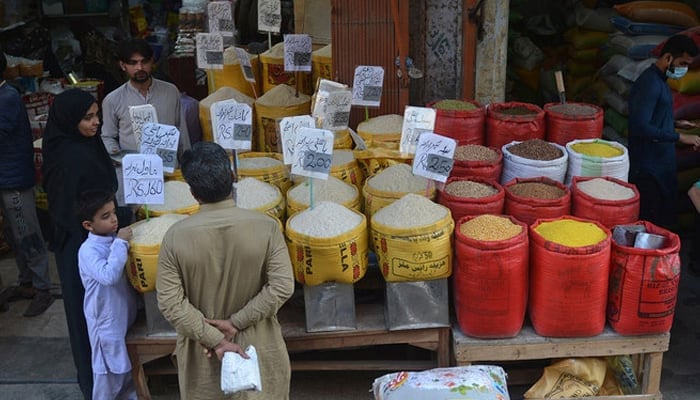Our Terms & Conditions | Our Privacy Policy
Pakistan among countries worst-hit by global food price inflation: UN report
People buy pulses and grains at a wholesale market in Karachi on February 1, 2023. — AFP
ISLAMABAD: Pakistan is among the countries worst affected by global food price inflation, recording some of steepest increases in cost of basic staples such as wheat and cooking oil between 2021 and 2024.
Food price inflation has severely impacted food security, pushing healthy diets out of reach for millions, and contributed to rising child malnutrition in the country.
According to United Nations’ flagship report, The State of Food Security and Nutrition in the World 2025, jointly produced by five UN agencies — FAO, UNICEF, WFP, IFAD and WHO — warns while global hunger has marginally declined, food insecurity remains alarmingly high in low- and lower-middle-income countries.
Pakistan, a lower-middle-income country, is highlighted for experiencing high food price inflation that outpaced general inflation, weakening household purchasing power and shrinking dietary diversity.
From 2021 to 2024, Pakistan, along with Nigeria and Mexico, saw sharpest price increases in starchy staples and edible oils, which are critical components of poor households’ diets. The report notes cost of a healthy diet in Pakistan fluctuated sharply due to seasonal disruptions and price shocks. In these countries, inflationary burden fell heavily on the poor, disproportionately affecting women and rural communities.
The affordability of a healthy diet has deteriorated significantly in Pakistan. While the global number of people unable to afford a healthy diet declined from 2.76 billion in 2019 to 2.60 billion in 2024, the number actually rose in lower-middle-income countries (LMICs) excluding India, from 791 million in 2019 to 869 million in 2024. This includes Pakistan, where structural food system weaknesses and currency devaluation have undermined affordability.
According to the report, food prices in Pakistan rose faster than overall inflation, intensifying food insecurity. A 10pc increase in food prices is associated with a 4.8 to 6.1pc rise in severe wasting among children under five years of age, a trend observed in Pakistan where wasting and stunting remain high.
The average global cost of a healthy diet rose to 4.46 dollars per person per day in 2024, up from 4.01 in 2022. In Asia, average cost stood at 4.43 dollars per person per day. For many Pakistanis, this cost is unaffordable, as incomes have not kept pace with food price inflation. Even those dependent on agriculture are affected, since most rural households are net food buyers.
The report confirms food insecurity is higher in rural areas than urban areas globally, and Pakistan fits this pattern. In 2024, 32pc of people living in rural areas worldwide were food insecure, compared to 24pc in urban areas. Women are also disproportionately affected due to lower incomes, care-giving responsibilities and weaker access to safety nets.
Child malnutrition remains a serious concern in Pakistan. Although South Asia overall saw some nutritional improvements, Pakistan continues to report high levels of child wasting, which is closely linked with food insecurity and unaffordable diets.
The report estimates child wasting globally remained at 6.6pc in 2024, while exclusive breastfeeding rose from 37pc in 2012 to 47.8pc in 2023. Yet, Pakistan lags behind in both indicators.
Neighbouring countries show a mixed picture. India has improved dietary affordability and food security, largely due to government subsidies and robust public distribution systems. Bangladesh has managed better control over food prices, while Afghanistan remains among worst-hit due to ongoing conflict, humanitarian crises and economic collapse.
The global context remains bleak despite minor improvements. Around 673 million people — 8.2pc of world’s population — were undernourished in 2024, down from 8.5pc in 2023. About 2.3 billion people, 28pc of world’s population, experienced moderate or severe food insecurity in 2024. Despite progress in Latin America and some parts of Asia, food insecurity continued to rise in Africa and Western Asia, which includes parts of Middle East and countries like Pakistan.
The report emphasises without urgent action, world will fall short of Sustainable Development Goal (SDG) 2: Zero Hunger by 2030. If current trends persist, 512 million people will be chronically hungry by 2030, with nearly 60 percent of them in Africa. Countries like Pakistan risk derailing both national development priorities and global hunger reduction efforts if inflation, poverty and food system vulnerabilities remain unaddressed.
The UN agencies recommend a comprehensive policy response: time-bound tax relief on food essentials, inflation-indexed social safety nets, investment in resilient and inclusive agri food systems, improved trade infrastructure and enhanced market transparency. For countries like Pakistan, policy coordination between monetary, fiscal and social institutions is deemed critical to protect the poorest and prevent future shocks.
As the report warns, global food price inflation has become one of the most pressing threats to food security, especially for vulnerable populations in South Asia, Africa and Latin America. For Pakistan, without decisive and inclusive interventions, ongoing crisis in food affordability could worsen public health outcomes and economic stability for years to come.
Images are for reference only.Images and contents gathered automatic from google or 3rd party sources.All rights on the images and contents are with their legal original owners.



Comments are closed.